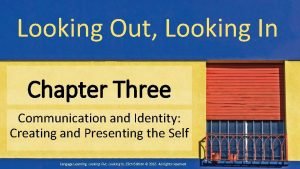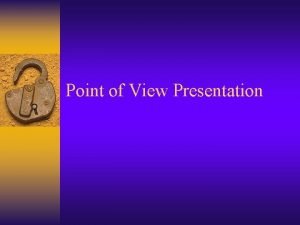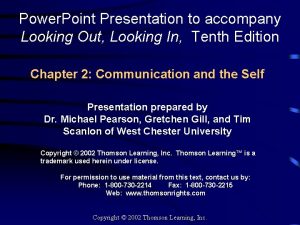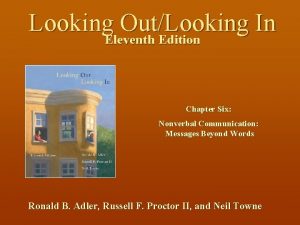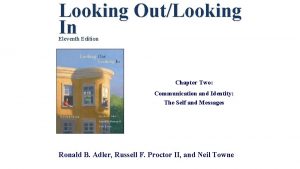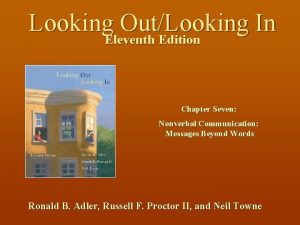Power Point Presentation to accompany Looking OutLooking In


















- Slides: 18

Power. Point Presentation to accompany Looking Out/Looking In, Tenth Edition Chapter 1: A First Look at Interpersonal Relationships Presentation prepared by Dr. Michael Pearson, Gretchen Gill, and Tim Scanlon of West Chester University Copyright © 2002 Thomson Learning, Inc. Thomson Learning™ is a trademark used herein under license. For permission to use material from this text, contact us by: Phone: 1 -800 -730 -2214 Fax: 1 -800 -730 -2215 Web: www. thomsonrights. com Copyright © 2002 Thomson Learning, Inc.

CHAPTER 1 A First Look at Interpersonal Relationships Copyright © 2002 Thomson Learning, Inc.

A First Look at Interpersonal Relationships • • • Why We Communicate The Process of Communication Principles and Misconceptions The Nature of Interpersonal Communication Communicating about Relationships Communication Competence: What Makes an Effective Communicator? Copyright © 2002 Thomson Learning, Inc.

Why We Communicate Physical Needs Identity Needs Social Needs Practical Goals • Instrumental Goals - getting others to behave in ways we want Copyright © 2002 Thomson Learning, Inc.

The Process of Communication A Linear View Linear Communication Model • Sender - encodes ideas and feelings • Message - organized ideas and feelings • Channel - means of conveying messages • Receiver - decodes the message • Noise - any forces that interfere with effective communication • Environments - fields of experience that help to understand others’ behavior Copyright © 2002 Thomson Learning, Inc.

The Process of Communication A Transactional View Transactional Communication Model • Feedback - response of a receiver to a sender’s message • Behavior - replaces the term of encoding, describes both deliberate and unintentional actions that can be observed and interpreted Copyright © 2002 Thomson Learning, Inc.

The Process of Communication Definition of Communication - a continuous, transactional process involving participants who occupy different but overlapping environments and create relationships the exchange of messages. Copyright © 2002 Thomson Learning, Inc.

Communication Principles and Misconceptions Communication Principles • Communication can be intentional or unintentional • It’s impossible not to communicate • Communication is irreversible • Communication is unrepeatable Copyright © 2002 Thomson Learning, Inc.

Communication Principles and Misconceptions Communication Principles • Meanings are not in words • More communication is not always better • No single person or event causes another’s reaction • Communication will not solve all problems Copyright © 2002 Thomson Learning, Inc.

The Nature of Interpersonal Communication Two Views of Interpersonal Communication 1. Quantitative Definition - based on the interaction between two people • Dyad - term used by social scientists to refer to two people interacting 2. Qualitative Definition - occurs when people treat one another as unique individuals Copyright © 2002 Thomson Learning, Inc.

The Nature of Interpersonal Communication Several features distinguish qualitatively interpersonal communication from less personal communication • Uniqueness • Irreplaceability • Interdependence • Amount of disclosure • Intrinsic rewards Copyright © 2002 Thomson Learning, Inc.

The Nature of Interpersonal Communication Technology and Interpersonal Communication • Computer mediated communication (CMC) – E-mail – Instant messaging – Online chat Copyright © 2002 Thomson Learning, Inc.

Communicating About Relationships Content and Relational Messages • Content - contains the subject being discussed • Relational - how the parties feel toward one another Metacommunication • Metacommunication - describes messages people exchange about their relationship Copyright © 2002 Thomson Learning, Inc.

Communicating About Relationships Types of Relational Messages 1. Affinity - the degree to which people like or appreciate one another 2. Respect - to be held in esteem by others 3. Control - the degree to which the parties have the power to influence one another Copyright © 2002 Thomson Learning, Inc.

Communicating About Relationships Types of Control • Decision • Conversational Distribution of Control • Complementary - when distribution of power is equal • Symmetrical - partners seek same degree of control • Parallel - power shifts from one to another, according to situation Copyright © 2002 Thomson Learning, Inc.

Communication Competence: What Makes An Effective Communicator? Communication Competence Defined Communication Competence – achieving one’s goals in a manner that, ideally, maintains or enhances the relationship in which it occurs • There is no “ideal” way to communicate. • Competence is situational. • Competence is relational. • Competence can be learned. Copyright © 2002 Thomson Learning, Inc.

Communication Competence: What Makes An Effective Communicator? Characteristics of Competent Communicators • A wide range of behaviors • Ability to choose the most appropriate behavior • Skill at performing behaviors (Four stages) 1. Beginning Awareness 2. Awkwardness 3. Skillfulness 4. Integration Copyright © 2002 Thomson Learning, Inc.

Communication Competence: What Makes An Effective Communicator? Characteristics of Competent Communicators • Cognitive Complexity - ability to construct a variety of different frameworks for viewing an issue • Self-Monitoring - paying attention to one’s behavior and using these observations to shape the way one behaves • Commitment - people who seem to care about relationships communicate better than those who don’t. Copyright © 2002 Thomson Learning, Inc.
 Breadth of penetration
Breadth of penetration Looking out looking in chapter 9
Looking out looking in chapter 9 Things that accompany salvation
Things that accompany salvation Accompany chapter 1
Accompany chapter 1 Deltopectoral groove
Deltopectoral groove Inkjet printers are considered legacy technology
Inkjet printers are considered legacy technology Topics for powerpoint presentation for class 4
Topics for powerpoint presentation for class 4 Power point presentation design west vancouver
Power point presentation design west vancouver Power triangle formula
Power triangle formula Informsu
Informsu Point point power
Point point power Richard iii pursuit of power
Richard iii pursuit of power Fetal brow
Fetal brow Fundal height transverse lie
Fundal height transverse lie Osha 10 hour construction powerpoint
Osha 10 hour construction powerpoint Point of view presentation
Point of view presentation The starting point in a presentation
The starting point in a presentation Solar power satellites and microwave power transmission
Solar power satellites and microwave power transmission Actual power and potential power
Actual power and potential power
